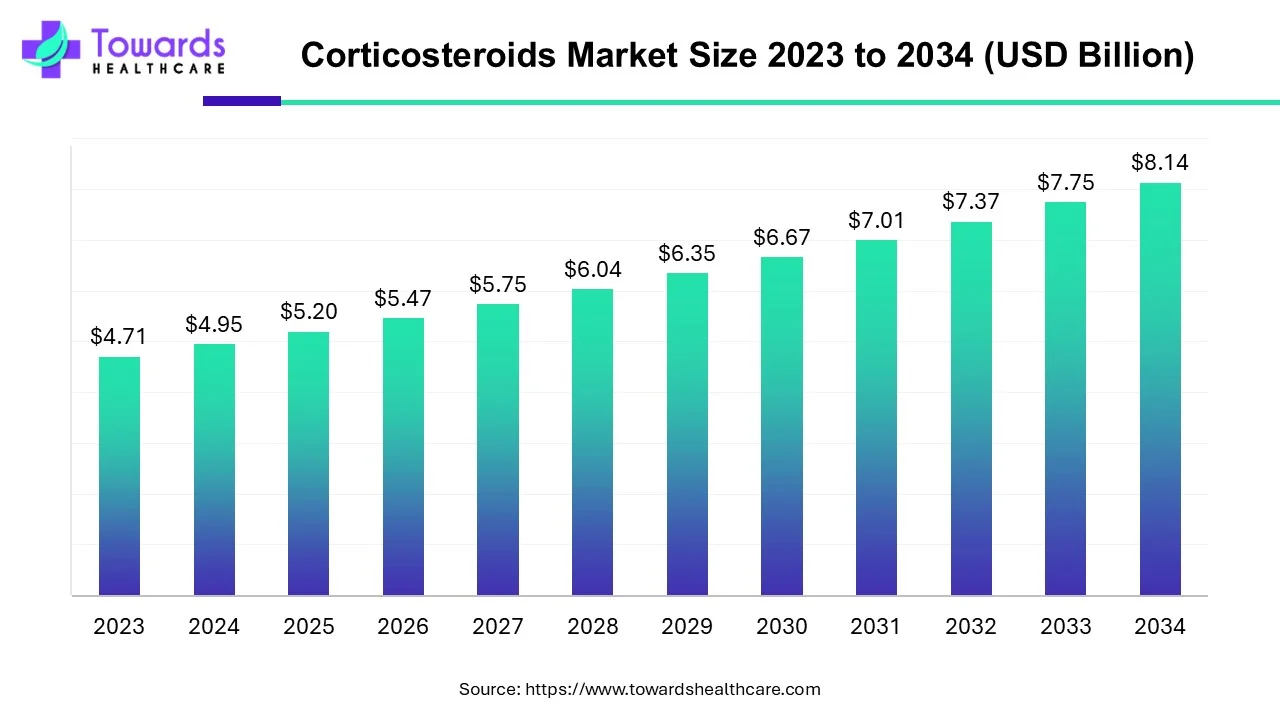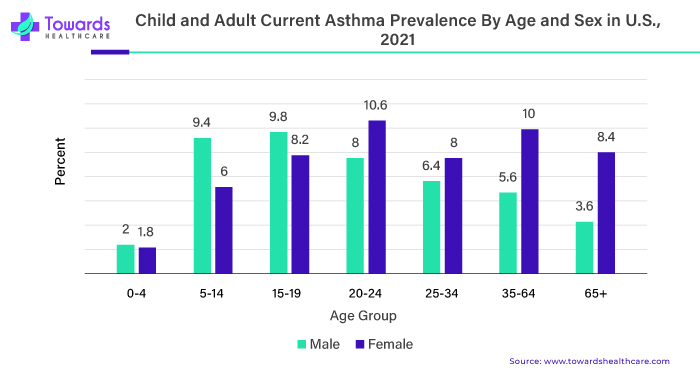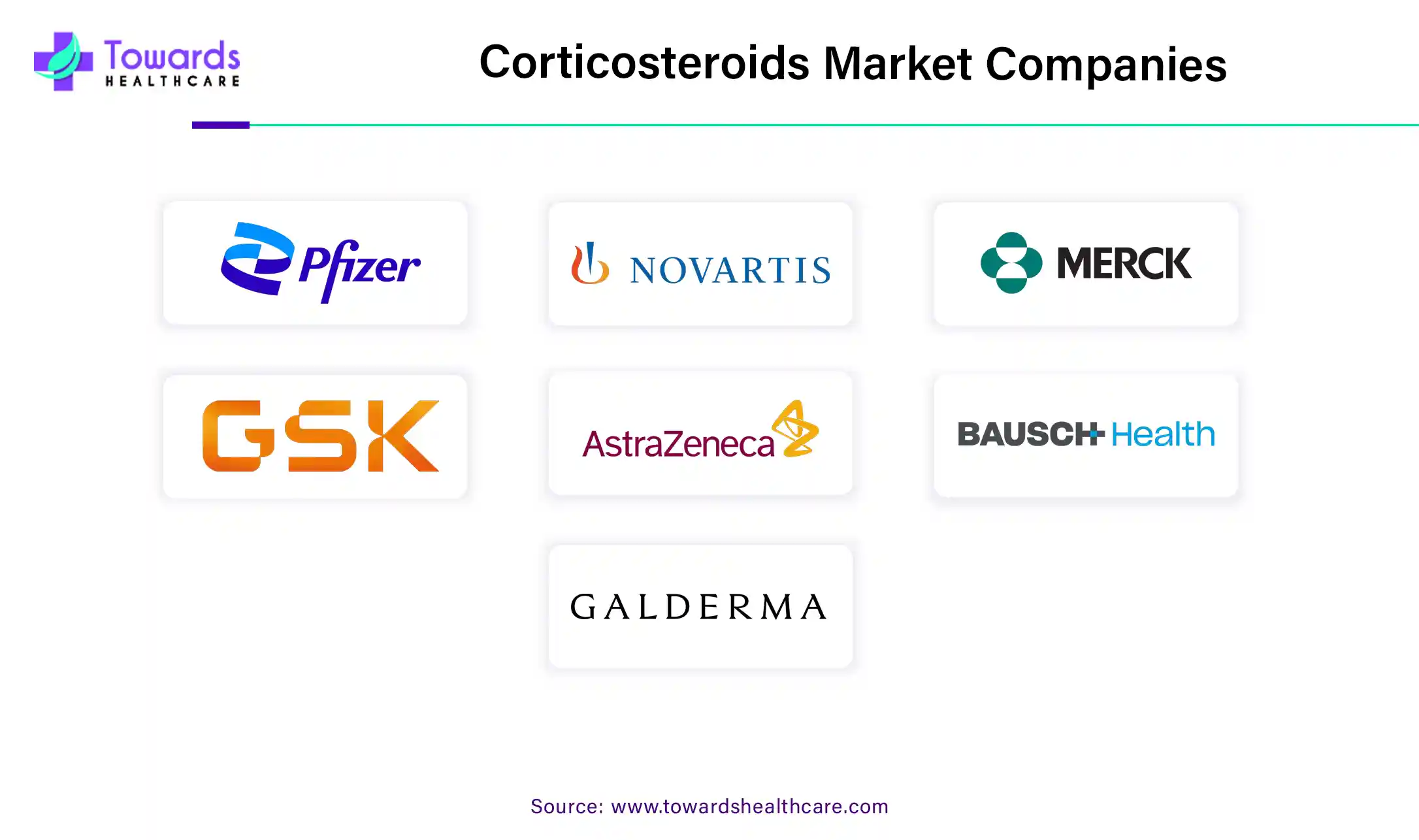December 2025

The corticosteroids market size was valued at US$ 5.2 billion in 2025 and is projected to grow to 5.47 billion in 2026. Forecasts suggest it will reach approximately US$ 8.55 billion by 2035, registering a CAGR of 5.10% during the period.

| Key Elements | Scope |
| Market Size in 2025 | USD 5.2 Billion |
| Projected Market Size in 2035 | USD 8.55 Billion |
| CAGR (2026 - 2035) | 5.10% |
| Leading Region | North America |
| Market Segmentation | By Product Type, By Route of Administration, By Application, By Product Form, By End User, By Geography |
| Top Key Players | Pfizer, Novartis, Merck & Co., Inc., GlaxoSmithKline, AstraZeneca, Bausch Health Companies Inc., Galderma, Cipla, Sanofi, Teva Pharmaceutical Industries Ltd. |
Pulmonology's application of corticosteroids, involving inhaling these medications directly into the lungs, is widely employed in managing respiratory conditions like asthma and chronic obstructive pulmonary disease (COPD). This approach holds significant potential to drive the growth of the corticosteroid market for several compelling reasons.

One key advantage of pulmonary application is its ability to provide localized treatment, delivering corticosteroids directly to the lungs where inflammation commonly occurs in respiratory conditions. This targeted delivery minimizes systemic exposure, mitigating the risk of systemic side effects while maximizing the therapeutic impact precisely at the site of inflammation. Compared to systemic administration methods, such as oral or injectable forms, inhaled corticosteroids generally exhibit lower systemic absorption. This characteristic reduces systemic side effects, such as bone loss or immune system suppression, making inhaled corticosteroids a preferred option for long-term use in chronic respiratory conditions.
Inhaled corticosteroids play a pivotal role in effectively managing inflammation within the airways, a fundamental aspect of respiratory diseases like asthma and COPD.
For instance,
This efficacy translates into improved symptom control, reduced exacerbations, and enhanced lung function. The convenience and patient-friendly nature of inhaled corticosteroids, typically administered through inhalers, contribute to increased patient compliance with prescribed treatment regimens. This adherence is crucial for effectively managing chronic respiratory conditions. The success of inhaled corticosteroids in managing respiratory conditions has prompted ongoing research into their potential application in other pulmonary disorders. This exploration could lead to an expanded range of indications for inhaled corticosteroids, further amplifying their demand in the market.
Combination therapies, wherein inhaled corticosteroids are paired with other respiratory medications like long-acting beta-agonists, offer a comprehensive approach to managing respiratory conditions. This integration contributes to the diversity of the market for respiratory medicines.
| Sr. No. | Combination Therapy | Indication |
| 1. | Inhaled corticosteroids (ICS) with long-acting bronchodilators (LABA) | This combination is frequently used for asthma. The LABA opens airways while the ICS reduces inflammation. Examples include fluticasone/salmeterol (Advair) and budesonide/formoterol (Symbicort). |
| 2. | ICS with long-acting muscarinic antagonists (LAMA) | This combination is commonly used for chronic obstructive pulmonary disease (COPD), another type of inflammatory lung disease. It targets different aspects of airway relaxation compared to ICS/LABA. Examples include fluticasone/umeclidinium/vilanterol (Trivento) and beclomethasone/glycopyrrolate/formoterol (Breztri Aerosphere). |
| 3. | Systemic Corticosteroids | These are typically used for short-term management of severe exacerbations of various pulmonary diseases, including asthma and COPD. They reduce inflammation but have more side effects than inhaled corticosteroids. |
| 4. | Triple Therapy | Combining ICS, LABA, and LAMA is sometimes used for patients with severe or poorly controlled COPD. This approach targets multiple mechanisms involved in the disease. |
As respiratory conditions remain prevalent worldwide, the demand for targeted and effective treatments like inhaled corticosteroids is expected to drive the growth of the corticosteroid market. Ongoing developments in formulations, devices, and combination therapies further enhance the market potential for the pulmonary application of corticosteroids.
The cost of corticosteroid medications, used to treat various medical conditions, can differ from one type of medication to another. Some newer versions or combinations of these medications might be more expensive. This can worry patients because if the medicines are too costly, it might be challenging to afford and get the treatment they need.
Imagine if you have a health issue requiring corticosteroids, and different options are available. Some of these options might be more advanced or combined with other medications to make the treatment more effective. However, these newer or combined versions might be pricier than the older ones.
For instance,
Affordability is a concern because if the medication is too expensive, some people might have trouble paying for it. This, in turn, can affect their ability to access the necessary treatment. Healthcare providers and policymakers need to consider these cost factors to ensure that people can afford the medications they need for their health. This way, everyone has a fair chance to get the treatment that can help them feel better without facing financial difficulties.
Which Product Segment Dominated the Corticosteroids Market?
The glucocorticoids segment held a dominant presence in the market in 2024, due to the rising prevalence of autoimmune disorders and high efficacy. Glucocorticoids regulate metabolism, inflammation, and immune responses. According to a recent study, more than 15 million people, or 4.6% of the U.S. population, were diagnosed with at least 1 autoimmune disease from January 2011 to January 2022. Glucocorticoids provide the fastest and most efficient way to control inflammation and have immune modulatory mechanisms.
Why Did the Topical Segment Dominate the Corticosteroids Market?
The topical segment held the largest revenue share of the market in 2024, due to the growing need for targeted therapy and easy application. Corticosteroids can be applied through the topical route by patients of all age groups, eliminating the need for skilled professionals. They directly enter the body fluids through the skin layers. The topical route has a faster onset of action and high bioavailability, bypassing the first-pass metabolism
How the Skin Allergies Segment Dominated the Corticosteroids Market?
The skin allergies segment contributed the biggest revenue share of the market in 2024, due to the rising prevalence of skin disorders and the ability to reduce inflammation. Contact allergies affect about 1 in 5 people, especially in females. Marketed topical corticosteroids act against hyperproliferation, immune dysregulation, and immune responses. They can treat a wide range of skin disorders, including psoriasis, eczema, atopic dermatitis, and alopecia areata.
What Made Hospital Pharmacies the Dominant Segment in the Corticosteroids Market?
The hospital pharmacies segment led the market in 2024, due to favorable infrastructure and the increasing number of hospital admissions. Hospitals possess the desired corticosteroid drugs that are prescribed by healthcare professionals. Patients prefer visiting hospitals as they have multidisciplinary experts and favorable reimbursement policies. Suitable capital investments enable hospital pharmacies to purchase innovative corticosteroid formulations.
North America boasts a well-developed healthcare infrastructure with advanced medical facilities, research institutions, and a high standard of healthcare delivery. This infrastructure supports diagnosing, treating, and managing a wide range of conditions, contributing to the demand for corticosteroid medications. Respiratory conditions, such as asthma and chronic obstructive pulmonary disease (COPD), are prevalent in North America. The region's corticosteroid market is significantly influenced by the demand for inhaled corticosteroids, commonly prescribed for managing these respiratory disorders.
Respiratory conditions, such as asthma and chronic obstructive pulmonary disease (COPD), are prevalent in North America. The region's corticosteroid market is significantly influenced by the demand for inhaled corticosteroids, commonly prescribed for managing these respiratory disorders. The ongoing collaboration between healthcare stakeholders, including government agencies, healthcare providers, and the pharmaceutical industry, continues to influence the landscape and ensure the effective use of corticosteroids in patient care.
According to the U.S. Pain Foundation, approximately 51.6 million adults, or 21% of the total population, live with chronic pain. The “Healthy People 2030” initiative by the Office of Disease Prevention and Health Promotion focuses on increasing prevention, detection, and treatment of respiratory diseases in the U.S.
It is estimated that more than 7 million Canadians are affected by inflammatory diseases of the skin, joints, or bowel. The “National Lung Health Framework” is an initiative by the Government of Canada to improve lung health among Canadians. The initiative focuses on preventing and managing respiratory diseases, including asthma.
The Asia-Pacific region is home to a large and diverse population, including developed and emerging economies. The sheer size and diversity of the population contribute to a significant market for corticosteroid medications to address various health needs. The region is witnessing increased research and development initiatives in the pharmaceutical sector. Ongoing efforts focus on developing new formulations, combination therapies, and targeted corticosteroid delivery methods, contributing to market growth. Some countries in the Asia-Pacific region are considered emerging markets for pharmaceuticals. The growing middle class, urbanization, and increasing healthcare investments create opportunities to expand the corticosteroid market.
In 2023, China was the leading exporter of corticosteroids, such as cortisone, hydrocortisone, prednisone, and prednisolone. China exported $167 million of corticosteroids, out of $247 million of global exports, mainly to India, the U.S., and Italy.
It is estimated that there are around 28 million people with asthma and 17 million people with COPD in India. India’s National Health Policy has set a goal of reducing premature deaths from NCDs, including chronic respiratory disorders, by 25% by 2025. This incentivizes the use of corticosteroids for their treatment.
The competitive landscape for the corticosteroid market is shaped by a mix of global pharmaceutical companies, regional players, and a diverse range of corticosteroid products catering to various therapeutic areas. Companies in the corticosteroid market offer a diverse range of products, including oral tablets, topical creams, ointments, nasal sprays, inhalers, and injectables. This diverse portfolio allows them to address various medical conditions, from skin disorders to respiratory and autoimmune diseases. Understanding the competitive landscape involves considering the intricate balance between innovation, market expansion, regulatory compliance, and strategic partnerships. Companies that effectively navigate these factors are well-positioned to thrive in the corticosteroid market.

By Product Type
By Route of Administration
By Application
By Distribution Channel
By Region
Middle East and Africa (MEA)
December 2025
December 2025
December 2025
December 2025